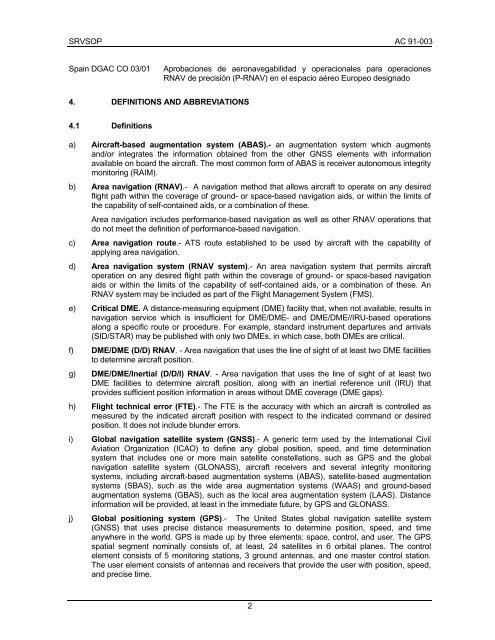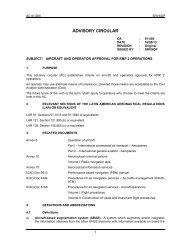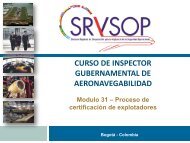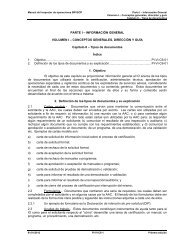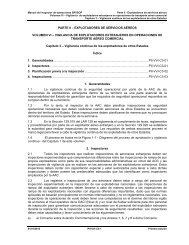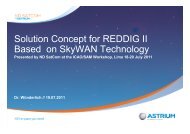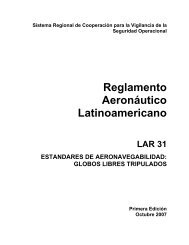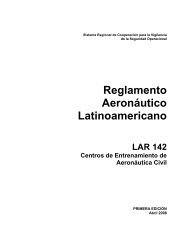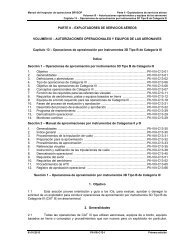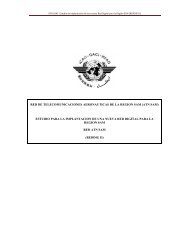ac 91-003 srvsop - ICAO
ac 91-003 srvsop - ICAO
ac 91-003 srvsop - ICAO
You also want an ePaper? Increase the reach of your titles
YUMPU automatically turns print PDFs into web optimized ePapers that Google loves.
SRVSOP AC <strong>91</strong>-<strong>003</strong><br />
Spain DGAC CO 03/01 Aprob<strong>ac</strong>iones de aeronavegabilidad y oper<strong>ac</strong>ionales para oper<strong>ac</strong>iones<br />
RNAV de precisión (P-RNAV) en el esp<strong>ac</strong>io aéreo Europeo designado<br />
4. DEFINITIONS AND ABBREVIATIONS<br />
4.1 Definitions<br />
a) Aircraft-based augmentation system (ABAS).- an augmentation system which augments<br />
and/or integrates the information obtained from the other GNSS elements with information<br />
available on board the aircraft. The most common form of ABAS is receiver autonomous integrity<br />
monitoring (RAIM).<br />
b) Area navigation (RNAV).- A navigation method that allows aircraft to operate on any desired<br />
flight path within the coverage of ground- or sp<strong>ac</strong>e-based navigation aids, or within the limits of<br />
the capability of self-contained aids, or a combination of these.<br />
Area navigation includes performance-based navigation as well as other RNAV operations that<br />
do not meet the definition of performance-based navigation.<br />
c) Area navigation route.- ATS route established to be used by aircraft with the capability of<br />
applying area navigation.<br />
d) Area navigation system (RNAV system).- An area navigation system that permits aircraft<br />
operation on any desired flight path within the coverage of ground- or sp<strong>ac</strong>e-based navigation<br />
aids or within the limits of the capability of self-contained aids, or a combination of these. An<br />
RNAV system may be included as part of the Flight Management System (FMS).<br />
e) Critical DME. A distance-measuring equipment (DME) f<strong>ac</strong>ility that, when not available, results in<br />
navigation service which is insufficient for DME/DME- and DME/DME//IRU-based operations<br />
along a specific route or procedure. For example, standard instrument departures and arrivals<br />
(SID/STAR) may be published with only two DMEs, in which case, both DMEs are critical.<br />
f) DME/DME (D/D) RNAV. - Area navigation that uses the line of sight of at least two DME f<strong>ac</strong>ilities<br />
to determine aircraft position.<br />
g) DME/DME/Inertial (D/D/I) RNAV. - Area navigation that uses the line of sight of at least two<br />
DME f<strong>ac</strong>ilities to determine aircraft position, along with an inertial reference unit (IRU) that<br />
provides sufficient position information in areas without DME coverage (DME gaps).<br />
h) Flight technical error (FTE).- The FTE is the <strong>ac</strong>cur<strong>ac</strong>y with which an aircraft is controlled as<br />
measured by the indicated aircraft position with respect to the indicated command or desired<br />
position. It does not include blunder errors.<br />
i) Global navigation satellite system (GNSS).- A generic term used by the International Civil<br />
Aviation Organization (<strong>ICAO</strong>) to define any global position, speed, and time determination<br />
system that includes one or more main satellite constellations, such as GPS and the global<br />
navigation satellite system (GLONASS), aircraft receivers and several integrity monitoring<br />
systems, including aircraft-based augmentation systems (ABAS), satellite-based augmentation<br />
systems (SBAS), such as the wide area augmentation systems (WAAS) and ground-based<br />
augmentation systems (GBAS), such as the local area augmentation system (LAAS). Distance<br />
information will be provided, at least in the immediate future, by GPS and GLONASS.<br />
j) Global positioning system (GPS).- The United States global navigation satellite system<br />
(GNSS) that uses precise distance measurements to determine position, speed, and time<br />
anywhere in the world. GPS is made up by three elements: sp<strong>ac</strong>e, control, and user. The GPS<br />
spatial segment nominally consists of, at least, 24 satellites in 6 orbital planes. The control<br />
element consists of 5 monitoring stations, 3 ground antennas, and one master control station.<br />
The user element consists of antennas and receivers that provide the user with position, speed,<br />
and precise time.<br />
2


